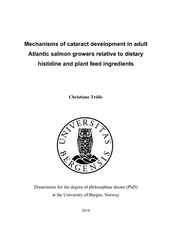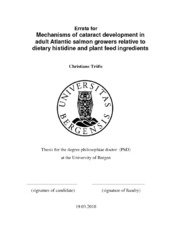| dc.contributor.author | Tröße, Christiane | eng |
| dc.date.accessioned | 2010-06-09T06:35:03Z | |
| dc.date.available | 2010-06-09T06:35:03Z | |
| dc.date.issued | 2010-03-19 | eng |
| dc.identifier.isbn | 978-82-308-0992-1 (print version) | en_US |
| dc.identifier.uri | https://hdl.handle.net/1956/3961 | |
| dc.description.abstract | Cataracts are defined as opacities of the eye lens and can be caused by a large number of risk factors. In aquaculture, cataracts in farmed Atlantic salmon (Salmo salar L.) represent an ethical problem and can cause economical losses. A series of studies have shown the cataract mitigating effect of dietary histidine (His) levels above the currently recommended minimum requirement in Atlantic salmon smolt and that dietary His levels are reflected in the concentrations of the His-derivative Nacetylhistidine (NAH) in the lens. However, the mechanism of lens protection by dietary His is not clear and no studies with adult Atlantic salmon growers have previously been carried out. Gene expression analysis in the lens is a powerful tool to investigate the molecular mechanisms of cataract formation in Atlantic salmon. In an initial study, the possible effects of different sampling procedures and tissue preservation methods on lens gene expression and lens RNA quality were investigated. Although there was no difference in RNA quality, tissue preservation in liquid nitrogen instead of RNAlater was recommended due to practical conditions in RNA extraction. Sampling procedures lasting up to two hours and procedures not employing anaesthetics provoked expression changes of selected antioxidant and stress-responsive genes. Thus, a quick sampling protocol not exceeding 30 minutes and the use of anaesthetics were recommended for future studies. A feeding trial was carried out to investigate the effects of different dietary His concentrations and His feeding regimes on lens and muscle imidazole concentrations and on cataract formation in adult Atlantic salmon growers. Fish in their second year in sea were fed one of three diets only differing in the His content [low His (L): 9 g/kg diet, medium His (M): 13 g/kg diet and high His (H): 17 g/kg diet] for four months (June to October). Dietary His concentrations were reflected in lens NAH and to a lesser degree in muscle anserine concentrations. Between July and September, fish developed cataracts with different severity in response to dietary histidine levels fed between June and September. Feeding at least 13 g His/kg diet from June to July mitigated later cataract formation. To identify molecular mechanisms involved in cataract formation, microarray analysis was applied to compare lens gene expression in groups of fish with cataracts of different severity caused by high or low dietary His levels. The differences in gene expression between the dietary groups were more pronounced in lenses sampled in October at a late stage of cataract formation than at an earlier state in September. At the late stage, 514 transcripts were significantly differentially expressed, while the same only applied to eight transcripts at the earlier state. Among the differentially expressed transcripts at the late stage were metallothionein A and B, as well as transcripts involved in lipid metabolism, carbohydrate metabolism, regulation of ion homeostasis and protein degradation. The differentially expressed transcripts could be categorized as “early” or “late” responsive, according to their expression pattern relative to progression in cataract formation. “Early” responsive transcripts might be used as molecular markers for early cataract formation in future studies; and one of the most promising candidates was SPARC (secreted protein acidic and rich in cysteine). In a second feeding trial, Atlantic salmon growers were fed one of four diets with varying inclusion levels of plant proteins and plant lipids (100% fish meal and 100% fish oil, 80% plant protein and 35% vegetable oil blend, 40% plant protein and 70% vegetable oil blend and 80% plant protein and 70% vegetable oil blend) for 12 months. The His concentrations differed in the diets dependent on the level of plant protein inclusion and were reflected in lens NAH concentrations. Fish fed the highest inclusion level of plant lipids had decreased growth rates and higher lens water contents than fish fed the marine control diet or the lower inclusion levels of plant lipids. The lenses of all groups fed plant feed ingredients were smaller than lenses of the control fish. Inclusion of dietary plant lipids led to slightly different lens fatty acid and lipid class composition. No severe cataracts were observed during the feeding study and there was no difference in cataract prevalence between the dietary groups. Lenses of fish from the plant feeding trial were examined for their ability to withstand osmotic disturbances ex vivo. Lens whole-organ culture in hypoosmotic and hyperosmotic media led to increase and decrease of lens volume, respectively. Lenses of plant diet-fed fish were less resistant to swelling and shrinking, released less NAH into the culture medium and accumulated His and NAH at higher rates than control lenses. Culture in hypoosmotic medium resulted in higher cataract scores than in hyperosmotic and control medium. mRNA expression levels of the selected genes glutathione peroxidase 4 (GPX4) and SPARC were affected by the diet and betaine aldehyde dehydrogenase by osmotic treatment of the lenses. The role of NAH as a lens osmolyte was confirmed. However, the ability to osmoregulate under hypoosmotic conditions was related to dietary plant lipid inclusion levels rather than lens NAH concentrations. | en_US |
| dc.language.iso | eng | eng |
| dc.publisher | The University of Bergen | en_US |
| dc.relation.haspart | Paper I: Tröße, C.; Waagbø, R.; Breck, O.; Olsvik, P. A (2010) Optimisation of gene expression analysis in Atlantic salmon lenses by refining sampling strategy and tissue storage. Fish Physiology and Biochemistry 36(4):1217-1225. Full text not available in BORA. The published version is available at: <a href="http://dx.doi.org/10.1007/s10695-010-9401-z" target="blank">http://dx.doi.org/10.1007/s10695-010-9401-z</a> | en_US |
| dc.relation.haspart | Paper II: Waagbø, R.; Tröße, C.; Koppe, W.; Fontanillas, R.; Breck, O. (2010) Dietary histidine supplementation prevents cataract development in adult Atlantic salmon, Salmo salar L, in seawater. British Journal of Nutrition 104(10): 1460–1470. The article is available at: <a href="http://hdl.handle.net/1956/7565" target="blank">http://hdl.handle.net/1956/7565</a> | en_US |
| dc.relation.haspart | Paper III: Tröße, C.; Waagbø, R.; Breck, O.; Stavrum, A. K.; Petersen, K.; Olsvik, P. A. (2009) Genome-wide transcription analysis of histidine-related cataract in Atlantic salmon (Salmo salar L). Molecular Vision 15: 1332-1350. The article is available at: <a href="http://hdl.handle.net/1956/3967" target="_blank"> http://hdl.handle.net/1956/3967</a> | en_US |
| dc.relation.haspart | Paper IV: Tröße, C.; Rhodes, J. D.; Sanderson, J.; Breck, O.; Waagbø, R. (2009) Effect of plant based feed ingredients on osmoregulation in the Atlantic salmon lens. Comparative Biochemistry and Physiology, Part B 155(4): 354–362. The article is not available in BORA due to publisher restrictions. The published version is available at: <a href="http://dx.doi.org/10.1016/j.cbpb.2009.12.002" target="blank">http://dx.doi.org/10.1016/j.cbpb.2009.12.002</a> | en_US |
| dc.title | Mechanisms of cataract development in adult Atlantic salmon growers relative to dietary histidine and plant feed ingredients | en_US |
| dc.type | Doctoral thesis | |
| dc.rights.holder | The author | en_US |
| dc.rights.holder | Copyright the author. All rights reserved | en_US |
| dc.subject.nsi | VDP::Landbruks- og Fiskerifag: 900::Fiskerifag: 920::Fiskehelse: 923 | nob |

